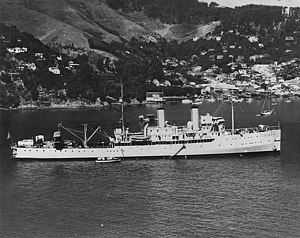USS Aroostook (CM-3)

USS Aroostook in harbor
|
|
| History | |
|---|---|
| Name: | USS Aroostook |
| Cost: | $1,350,000 (hull and machinery) |
| Launched: | 26 March 1907, as SS Bunker Hill |
| Acquired: | 12 November 1917 |
| Commissioned: | 7 December 1917 |
| Decommissioned: | 10 March 1931 |
| Renamed: | Aroostook, November 1917 |
| Reclassified: |
|
| Struck: | 5 February 1943 |
| Fate: | Sold for scrap in October 1947 |
| General characteristics | |
| Type: | Minelayer |
| Displacement: | 3,800 long tons (3,900 t) |
| Length: | 395 ft (120 m) |
| Beam: | 52 ft 2 in (15.90 m) |
| Draft: | 16 ft (4.9 m) |
| Speed: | 20 kn (23 mph; 37 km/h) |
| Complement: | 313 |
| Armament: | 1 × 5 in (130 mm)/51 cal gun, 2 × 3 in (76 mm)/50 cal dual purpose guns, 2 × .30 in (7.6 mm) Colt machine guns |
The USS Aroostook (ID-1256/CM-3/AK-44) was the Eastern Steamship Company's Bunker Hill converted for planting the World War I North Sea Mine Barrage. Bunker Hill was built in 1907 at Philadelphia, Pennsylvania for passenger service between Boston and New York City. Bunker Hill and her sister ship Massachusetts were among the eight ships acquired by the U.S. Navy in November 1917. The two coastal passenger steamers were converted to minelayers at the Boston Navy Yard.
After a brief shakedown cruise in mid-June 1918, Aroostook took on board a load of mines and then began a voyage across the Atlantic Ocean in the company of her sister minelayer, the USS Shawmut. This voyage, aided by the novel technique of refueling at sea, took her to Scotland, where in July she participated in laying the North Sea Mine Barrage, laying thousands of mines across the mouth of the North Sea in order to create a barrier for German U-boats trying to depart from German seaports to the open Atlantic. Aroostook laid a total of 3,180 mines in this operation:
This effort, nearly completed, was the major operation of the U.S. Navy in European waters during World War I, and it came to an end on 11 November 1918 with the Armistice with Germany and the end of fighting in World War I. The USS Aroostook steamed home to the East Coast in December 1918
During the spring of 1919, the USS Aroostook was refitted as an "aircraft tender" to support the attempt by U.S. Navy naval aviators to make the first transatlantic crossing of the Atlantic Ocean by air. The Navy had four huge Curtiss NC floatplanes built for the project. These aircraft were twice the size of contemporary aircraft. The route for this attempt used southeastern Newfoundland and the Portuguese Azores Islands as stopping-off points for refueling and maintenance work on the new planes, and for rest and mess periods for their aviators. In the event of the attempt, mechanical problems and lack of replacement parts necessitated the cannibalization of one of the aircraft, leaving three "Nancys" for the attempt.
...
Wikipedia
